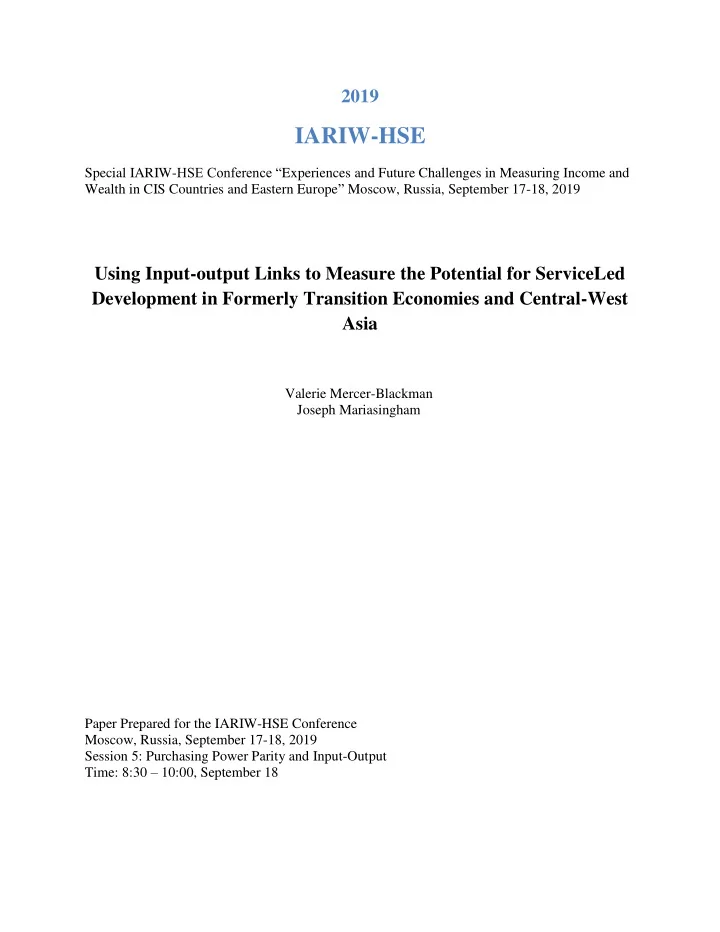

2019 IARIW-HSE Special IARIW- HSE Conference “ Experiences and Future Challenges in Measuring Income and Wealth in CIS Countries and Eastern Europe ” Moscow, Russia, September 17-18, 2019 Using Input-output Links to Measure the Potential for ServiceLed Development in Formerly Transition Economies and Central-West Asia Valerie Mercer-Blackman Joseph Mariasingham Paper Prepared for the IARIW-HSE Conference Moscow, Russia, September 17-18, 2019 Session 5: Purchasing Power Parity and Input-Output Time: 8:30 – 10:00, September 18
Using Input-output Links to Measure the Potential for Service- Led Development in Formerly Transition Economies and Central-West Asia . By: Valerie Mercer-Blackman and Joseph Mariasingham* Abstract Many Central-west Asian countries have not diversified their economies according to traditional indicators, leading policy analysts to suggest that the objective should be to increase the share of manufacturing employment in the economy to levels similar to East Asian countries. This paper uses input-output analysis to develop a better measure of diversification that accounts for global production links and suggests that the key to development for these primary product exporting economies is business and professional services, even if they are not directly exported. The paper also looks at measures of comparative advantage and diversification and explains why worries of premature deindustrialization are unwarranted if value-added contribution is properly measured. Draft completed August 31 for presentation to the IARIW-HSE Conference, September 2019. Not for quotation . Keywords: structural transformation, diversification, input-output tables, comparative advantage, premature deindustrialization, global value chains JEL codes: F15, F23, O14 * Valerie Mercer-Blackman (vmercerblackman@adb.org), Senior Economist and Joseph Mariasingham (mmariasingham@adb.org), Senior Statistician, both at the Economics Research and Regional Cooperation Department, Asia Development Bank (ADB), Manila Philippines. The authors would like to thank excellent research assistance by Krizia Anne Garay, Shiela Camingue-Romance and Kristin Baris. All errors are our own. The ideas expressed here do not necessarily reflect those of the ADB or their member countries.
Contents 1. Introduction ..................................................................................................................... 3 2. Literature Review ............................................................................................................ 4 What’s going on with the country structures and how different to OECD comparators? 3. ... 8 Indicators of diversification .................................................................................................. 9 4. Findings..........................................................................................................................11 4a. Approach and Methodology .........................................................................................11 4b. Results of Dot-plot Matrix Observations .......................................................................12 4c. The Agglomeration Index .............................................................................................16 4d. Results of the juxtaposition with trade in value added indicators ..................................20 4e. The special role of business and professional services ................................................21 4e. Data issues .................................................................................................................24 5. Conclusions and Policy Implications .................................................................................25 BIBLIOGRAPHY ....................................................................................................................27 Appendix 1. Agglomeration of Economic Sector-Specific Productive Activities Using the Dot- Plot Matrix Representation (see legend for sector description) ..............................................31 Appendix 2: Revealed Comparative Advantage .....................................................................47 Appendix 3. Servitization in Oil and Gas Services in Kazakhstan ..........................................48 2
1. Introduction The countries of the Former Soviet Union (FSU) have had a unique development path since the time of the breakup . Following the independence of republics since 1990, carefully crafted production and distribution links were severed, factory towns specializing in one aspect of production were shut down, trade came to a halt within republics and commonwealth countries, and in some cases the desire for sovereignty of newly-independent republics and inward-looking policies may have eroded networks and trade links. At least a decade of growth was lost. Since then, most countries have recovered and transitioned for the most part to be grouped with the so- called ‘emerging market economies’ . Yet their development path has been quite different following the steep output drop, and certainly started this century with a higher average level of education and scientific knowledge than other countries at similar income range. These long-term developments contrast with the conventional path of structural change typically studied in the literature. The more ‘conventional’ path has seen countries move from being largely agriculture-based, to manufacturing, to services in tandem with development from middle-income to high-income status towards the end of the 20th century. In studying the features of countries that have moved to high-income status, two pre-requisites are often stressed in the literature. First, the need for economic diversification, which for manufacturing is achieved through diversification of the export product space (Hausmann and Hidalgo, 2011). Second, the importance of developing a strong manufacturing base, as measured by the share of employment in manufacturing to total employment. Two recent phenomena have occurred which have some development practitioners ‘worried’ that current middle -income and transition economies may not quickly join the club of developed countries: (i) so- called ‘premature deindustrialization’ in which the manufacturing employment share is peaking earlier for their level of development and at much lower shares (for example, Rodrick, 2016); and (ii) the development of mostly domestic-origin (but possibly foreign-financed) high-tech enclave service-sector economies which ’skip’ the stage of greater diversification of the manufacturing export base. This paper seeks to explain to what extent these ‘worries’ are based on misconceptions about the importance of manufacturing and industry. The development of capabilities as many economies of the Organisation of Economic Cooperation and Development (OECD) grew to become high-income happened simultaneously during the heyday of manufacturing and industry, leading many to attribute a lot of the acquisition of capabilities to the process of manufacturing per se. Since then, production processes have changed drastically and there are serious mismeasurements of services productivity and the contribution of non-tradable services to manufacturing. The paper dispels the myth that there is something ‘special’ about diversification of the manufacturing processes that needs to be replicated for an economy to increase its wealth. New studies using firm-level data for mostly European countries (Crozet and Milet, 2015; Bernard et.al, 2017) and for developing Asia (Ablaza and Mercer-Blackman, 2018), OECD (Miroudot and Cadestin, 2017) and United States (US) (Berlingieri 2014) have found that when the value-added contribution of non-tradable services to the production and exports of goods is properly accounted for, services become critical for a knowledge-based economy, in particular business and professional services. 3
Recommend
More recommend